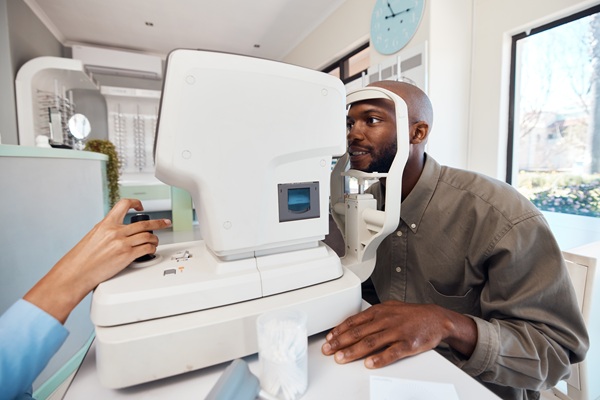Understanding Myopia: Symptoms, Causes, and Treatment Options

Vision problems are common, so much so that they have become easily accommodated with the help of an optometrist. Patients with myopia can get clearer vision with prescription glasses and contact lenses. Surgical procedures for permanent vision correction are also available. Making an informed decision about vision correction for myopia starts with understanding the symptoms and causes.
The basics of myopia
With myopia, patients can see nearby objects clearly but not those in the distance, such as television screens or road signs. Therefore, myopia is more commonly known as nearsightedness. When the eyes are otherwise healthy, it is classified as simple myopia. There is also a variant known as pathological myopia, which develops due to degenerative changes in the retina.
Corrective lenses may help with both types of myopia. An optometrist can also provide treatments to manage the retinal degeneration behind pathological myopia.
Myopia signs and symptoms
It is common to be unaware that one has myopia because they are used to seeing that way, having had it since childhood or having developed it slowly over time. However, this can lead to problems while driving, during meetings, school, or leisure activities such as reading, watching movies, or playing sports. In addition, it can cause uncomfortable symptoms like headaches from eye strain. Per the National Eye Institute, other common signs and symptoms of myopia include:
- Getting tired quickly when having to do tasks that require distance vision
- Needing to squint to see objects or words far away
- Blinking more often than usual
- Dry, watery, or sore eyes
- Light sensitivity
An optometrist can diagnose patients with myopia through a routine eye examination. They will ask the patient to read a Snellen eye chart with various letters decreasing in size from top to bottom. If patients have issues reading any part of the chart, they will use a phoropter to create a custom prescription. A phoropter is an instrument that cycles through different lenses, revealing whether the patient has myopia or hyperopia (farsightedness).
What causes myopia?
Errors in how the cornea refracts light cause myopia. The Mayo Clinic states this refractive error occurs due to an oval-shaped eye or a steeply curved cornea. Thus, myopia can be genetic.
That said, a family history of myopia does not guarantee it. Rather, it makes a person predisposed to it. Environmental factors — such as spending too much time on the computer, using a smartphone, or reading — increase one’s likelihood of developing myopia.
Myopia treatments from an optometrist
Corrective lenses can accommodate myopia, providing clear vision whenever the patient wears them. However, surgical procedures designed to offer a more permanent solution for myopia are also available. Explore these myopia treatments in greater detail below.
Corrective lenses
Eyeglasses and contact lenses are corrective lenses that use a custom prescription created during an eye exam. Contact lenses require an additional exam to ensure the eyes can support them, primarily by testing for sufficient lubrication. The optometrist will measure the size of the cornea and then recommend soft, disposable, or extended-wear contacts accordingly.
Alternatively, eyeglasses do not require testing beyond the eye exam. Most optometrist offices have a wide selection of eyeglass frames, from masculine and feminine to unisex. An optician can help patients find frames that fit their unique style and eye care needs. For example, a higher prescription will likely need thicker frames to hold thick lenses, while wire-rimmed glasses are a good choice for patients with lower prescriptions.
Once frames are selected, the optician will fit them to the patient’s face. This primarily involves marking pupillary distance so the prescription lenses sit within the frame for optimal vision correction. It can take about two weeks to get prescription glasses back from the lab.
Surgical procedures
Corrective lenses are not the only way to get clearer vision. Patients with myopia may get permanent vision correction through surgery. While optometrists do not usually perform these surgeries themselves, they can recommend and discuss them. Examples include:
- LASIK. Laser-assisted in situ keratomileus, in which the inner corneal tissue is reshaped with a laser.
- LASEK. Laser-assisted subepithelial keratectomy, in which the outer layers of the cornea are reshaped with a laser.
- PRK. Photorefractive keratectomy, in which a laser is used to flatten the cornea.
- Intraocular lenses. A procedure in which the natural lens is surgically replaced.
- Vitrectomy. A procedure in which retina tears and detachments are addressed by removing vitreous gel between the retina and the lens.
Consult an optometrist about myopia
If you have noticed the signs of myopia in yourself or your child, an optometrist can diagnose it and create a custom prescription in an appointment. You can also ask these healthcare providers about surgical myopia treatments. To book an appointment, contact our Dallas team at Texas Optical today.
Request an appointment here: https://www.texasoptical.net or call Texas Optical at (214) 771-7333 for an appointment in our Dallas office.
Check out what others are saying about our services on Yelp: Read our Yelp reviews.
Recent Posts
Contact lens exams are fundamental to maintaining clear vision and promoting overall eye health. Many individuals rely on contact lenses for daily activities, sports, and social events, yet consistent monitoring of lens fit and eye condition often receives less attention than it deserves. An optometrist specializing in evaluating the cornea, tear film, and general ocular…
Red, irritated eyes can result from something as simple as fatigue or dryness. However, persistent or severe symptoms may indicate a more serious condition requiring red eye treatment from an optometrist. Understanding when those everyday symptoms become something more serious is key to protecting long-term vision and avoiding complications. Catching the signs early on and…
Vision health is an important part of your everyday life. When urgent and unexpected issues arise, you must seek emergency eye care from an optometrist. Whether the issue results from trauma, infection, or sudden changes, immediate attention from an optometrist can prevent complications and preserve your long-term ocular health.Individuals may need emergency eye care for…
A myopia optometrist can help manage and slow the progression of nearsightedness, especially in children and young adults. Nearsightedness, or myopia, causes distant objects to appear blurry while close-up vision remains clear. Without proper care, myopia can worsen over time, leading to higher prescriptions and an increased risk of eye health problems.Myopia occurs when the…


